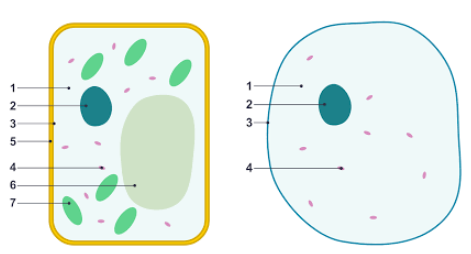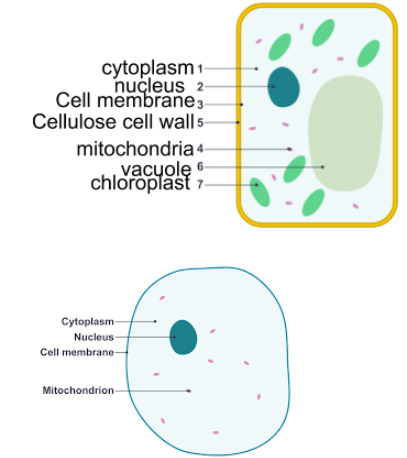
Label the parts of the diagrams given below.Identify which one is the plant cell and which one is animal cell.


Answer
563.7k+ views
Hint:As well as a cell membrane, plant cells have a cell wall. The cell wall of plants covers the cell membrane. This gives its distinctive rectangular form to the plant cell. The cells of animals simply have a cell membrane, but no wall of cells.
Complete answer:

Note:The fundamental unit of life is the cell. Many of life's events are done by cells. Organisms are defined on the basis of the number of cells in them. Unicellular species are single-celled, although there are a significant number of cells in multicellular organisms.
Complete answer:

| Animal cell | Plant cell | |
| Definition | Animal cells are also the basic functional unit of life for all cell organelles constituted by animals that perform a range of functions to support the metabolisms of animals. | Plant cells are essential plant functional units that make up all cell organelles that perform a range of functions that support the metabolisms of the plants. |
| Size and Shape | Animal cells are generally smaller with their cells varying in length from 10-30um than plant cells.The shape and sizes of animal cells, most defined by the role they play, vary greatly from irregular shapes to round shapes. | With the cell size varying from 10um-100um in length, plant cells are larger than animal cells.With most cells being rectangular or cube-shaped, plant cells are similar in type. |
| Cell wall | They lack a cell wall, but they have a plasma (cell) membrane that supports and protects the cell from external damage.It also plays a major role in the selective permeability of nutrient molecules, water, and other cell components, allowing in and outflow. | They both have a cell wall consisting of a cell membrane and cellulose. The cell wall is, on the surface of all plant cells, a rigid membrane matrix whose primary function is to protect the cell and its contents. |
| Cytoplasm | All the cell organelles are housed in it. | It hosts most of the organelles of the cell |
| Vacuoles | There may be several tiny vacuoles in animal cells, much smaller than plant cells. | Plant cells have a large central vacuole capable of occupying up to 90% of the volume of the cell. |
| Nucleus | Present, and it is located at the middle of the cell | Present, and it is located at the side of the cell |
| Plastids | Absent | They provide the plants with pigmentation colour and also promote the trapping of light energy used for photosynthesis. |
Note:The fundamental unit of life is the cell. Many of life's events are done by cells. Organisms are defined on the basis of the number of cells in them. Unicellular species are single-celled, although there are a significant number of cells in multicellular organisms.
Recently Updated Pages
Why are manures considered better than fertilizers class 11 biology CBSE

Find the coordinates of the midpoint of the line segment class 11 maths CBSE

Distinguish between static friction limiting friction class 11 physics CBSE

The Chairman of the constituent Assembly was A Jawaharlal class 11 social science CBSE

The first National Commission on Labour NCL submitted class 11 social science CBSE

Number of all subshell of n + l 7 is A 4 B 5 C 6 D class 11 chemistry CBSE

Trending doubts
Differentiate between an exothermic and an endothermic class 11 chemistry CBSE

10 examples of friction in our daily life

One Metric ton is equal to kg A 10000 B 1000 C 100 class 11 physics CBSE

Difference Between Prokaryotic Cells and Eukaryotic Cells

1 Quintal is equal to a 110 kg b 10 kg c 100kg d 1000 class 11 physics CBSE

State the laws of reflection of light




